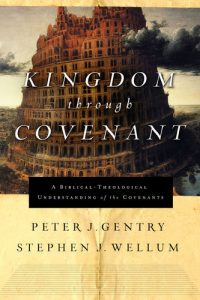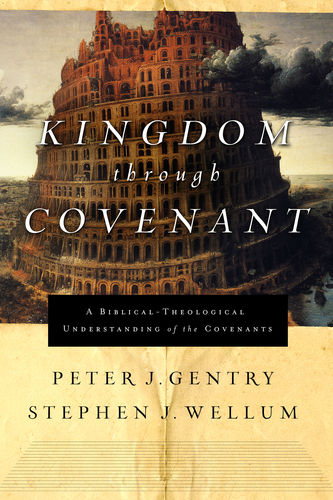Gentry, Peter J. and Stephen J. Wellum. Kingdom Through Covenant: A Biblical-Theological Understanding of the Covenants. Wheaton, Illinois: Crossway, 2012, pp. 848, $45.00, hardback.
Peter J. Gentry serves as Donald L. Williams Professor of Old Testament Interpretation at the Southern Baptist Theological Seminary and as Director of the Hexapla Institute.
Stephen J. Wellum serves as Professor of Christian Theology at the Southern Baptist Theological Seminary and as Editor of The Southern Baptist Journal of Theology.
In Kingdom Through Covenant, Peter J. Gentry and Stephen J. Wellum establish a biblical and systematic theology designed to “show how central the concept of ‘covenant’ is to the narrative plot structure of the Bible, and secondly, how a number of crucial theological differences within Christian theology, and the resolution of those differences, are directly tied to one’s understanding of how the biblical covenants unfold and relate to each other” (p.21). In effect, they contend that to know the covenants rightly is to know the Scriptures rightly (pp. 139, 603, 611). As such, they examine each OT covenant so as “to speak on its own terms” (p. 113) by aligning interpretation to 1) its immediate textual context, especially emphasizing a historical-grammatical hermeneutic of a covenantal text, 2) its epochal point in redemptive history, especially to what preceded it to ground the categories of covenants, and 3) its typological reception within the canon by latter texts in response to saving events in redemptive history (p. 93). They build their “‘thick’ reading of Scripture” (p. 89), which is their version of a canonical reading, in the covenant’s representation in the text and its position in progressive revelation so that the covenants define the points of comparison for typology (pp. 89–108; 606). They argue for a typological development from creation (Adam and Noah) and Israel (Moses and David) to the person and work of Jesus in the New Covenant (NC) with the Abrahamic Covenant (AC) playing the major role in their connections and in the critique of Covenant Theology (CT) and Dispensational Theology (DT).
Their “progressive covenantalism” (p. 24) aims to stand between the readings of CT and DT because both systems fail to follow the trail of typological links in the covenantal aspect most dear to their model (pp. 24, 113, 121). “[I]n order to discern properly how Old Testament types/patterns are brought to fulfillment in God’s plan, Jesus and the new covenant must become the hermeneutical lens by which we interpret the fulfillment of the types” (p. 608). They contend that CT too quickly equates circumcision with baptism without connecting circumcision to Christ first. CT settles, therefore, on an ecclesiology that equates the nature of Israel and the Church as mixed, visible and invisible, affirming paedobaptism. Progressive covenantalism, however, accepts a regenerate church and believer’s baptism that reflects the nature of Christ and the new covenant. In the same way, DT fails to appreciate that the antitype to the land and the creation itself is “the new creation that Jesus has inaugurated in the new covenant” (p. 607). The eschatology of DT, accordingly, moves too quickly to set the promised land in its old setting rather than as new creation, severing it from its typological development through the covenants to Christ and His perfect work.
This perfect work of Christ as King of His Kingdom is accomplished in the new covenant whose scope is the “the entire universe” (p. 592). His creation of everything, in other words, typologically anticipates its redemption in Christ that extends God’s rule “throughout the life of the covenant community and to the entire creation … in the context of a covenant relationship of “loyal love” (hesed) and “faithfulness” (emet)” (p. 594). These paired terms from the covenants (pp. 144–145) find their typological fulfillment in Christ, allowing the new covenant to supersede the older covenants because “we are no longer under those previous covenants as covenants, since they reached their fulfillment in Christ” (p. 605). As they advance their argument, Wellum and Gentry also reject seeing these covenants as merely unconditional or conditional because each covenant displays aspects of both in “a deliberate tension” (p. 609). Each covenant is “unconditional or unilaterally guaranteed by the power and grace of God” (p. 610). At the same time, each one demands an obedient partner, a condition, that frustrates the reader as “one works across the covenants and the tension increases” (p. 611). This magnifying tension eliminates any hope that a mere man can meet this condition and leaves open only one possibility: God Himself will act to keep the condition of “a new and better covenant” (p. 611).
In chapters 1–3, Wellum and Gentry establish the importance of covenants to the Scriptures and theology. They highlight how CT and the various versions of DT come to differing conclusions based on their understanding of the covenants, especially in light of ecclesiology and eschatology. The nature of God’s people remains the primary evidence for underlying differences. Neither CT or DT consistently binds all of its conclusions to the Christological implications of the progressive and predictive nature of typology.
In chapters 4–11, therefore, Wellum and Gentry analyze each of the Old Testament (OT) covenants, beginning with defining the very nature of Ancient Near Eastern (ANE) covenants. In particular, they focus on the word pair hesed and emet, “loyal love” and “faithfulness” (p. 141). These terms serve as their semantic backbone for each covenant. Wellum and Gentry turn, next, to the Noahic covenant and define it as the confirmation of the original Adamic covenant that extends it to Noah and his descendants as it is “established” (p. 161). In a similar manner, they mark the Abrahamic covenant as one that is “cut” in Gen 15:18 and “established” in Gen 17:17. It becomes the centerpiece of God’s work to bless humanity and show his “loyal love” and “faithfulness” (pp. 245, 280). As Wellum and Gentry turn to the Israelite (Mosaic) covenant, they find the Ten Commandments and the covenant begun in Exod 19–24 as foundational to the expression of God’s will, contending that Deuteronomy stands as a renewal and “supplement to the covenant at Sinai” (pp. 379–381) so that Israel may “fulfill the Adamic role reassigned to Abraham” (p. 388). When they pivot to examine the Davidic covenant, therefore, they link it to both the AC, whose blessings will come “through the Davidic King/kingdom” (p. 427), and to the MC because this kingship will be “a means of accomplishing Exo 19:3b–6” (p. 422).
In chapters 12–15, Wellum and Gentry develop their understanding of the New Covenant by tracing its proclamation in Isaiah, Ezekiel, Jeremiah and Daniel before turning to its proclamation in the NT. They focus on Ephesians and link the shape of the text and the new covenant community to the expectations embedded in Exod 19–24 (pp. 565–570). Paul’s instructions to the Ephesians draw together and fulfill the elements of hesed and emet from the earlier covenants with the call to speak truth in love (pp. 570–582) so that loving Jesus and others manifests itself in a renewed humanity that seeks social justice as a community through Jesus (pp. 582–587).
In chapters 16–17, Wellum and Gentry complete their project by defining their approach, “Kingdom through Covenant” as a canonical reading that embraces the story of Scripture through the covenants before stretching the implications of their work into “theology proper, Christology, ecclesiology and eschatology” (p. 653).
This volume serves as a needed reference for any scholar who pursues biblical theology within the evangelical traditions. Its cumulative argument advances a reasonable case for its main thesis, especially by the detailed testing of its ideas through many key parts of the Scripture. They demonstrated that the covenants can be understood to frame the reading of Scripture and the development of theology. However, this project and the validity of its thesis depends heavily on its methodological starting points, especially its view of typology and its equating of the covenants with Scripture. If typology should not be grounded in the relationship of the covenants but in the author’s acts of composition and canonization, for example, then typology may be broader than described. Their thesis, then, may have too narrowly defined how the different aspects of the Scriptures form connections, create exegetical comparisons and develop theology across a biblical book, books and the whole canon. Despite these limitations, Wellum and Gentry have in this work helped the various Protestant interpretive camps to understand each other and the Scriptures better.
Peter Link, Jr.
Charleston Southern University





